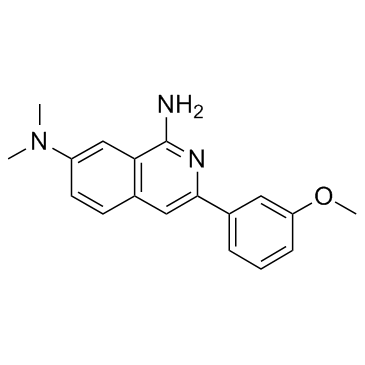3-arylisoquinolinamine derivative
Modify Date: 2025-09-18 16:22:15

3-arylisoquinolinamine derivative structure
|
Common Name | 3-arylisoquinolinamine derivative | ||
|---|---|---|---|---|
| CAS Number | 1029008-71-6 | Molecular Weight | 293.36300 | |
| Density | N/A | Boiling Point | N/A | |
| Molecular Formula | C18H19N3O | Melting Point | N/A | |
| MSDS | N/A | Flash Point | N/A | |
Use of 3-arylisoquinolinamine derivative3-arylisoquinolinamine derivative is a 3-arylisoquinolinamine derivative with antitumor activity. |
| Name | 3-(3-Methoxyphenyl)-N7,N7-dimethyl-1,7-isoquinolinediamine |
|---|---|
| Synonym | More Synonyms |
| Description | 3-arylisoquinolinamine derivative is a 3-arylisoquinolinamine derivative with antitumor activity. |
|---|---|
| Related Catalog | |
| Target |
IC50: 21 nM (breast MDA-MB-231), 19 nM (pancreas PANC-1), 17 nM (colon HCT 116), 19 nM (prostate PC3), 14 nM (ovary OVCAR-3), 32 nM (melanoma SK-MEL-28), 22 nM (kidney Caki-1), 32 nM (glioblastoma SNB19)[1] |
| In Vitro | 3-arylisoquinolinamine derivative is a 3-arylisoquinolinamine derivative, extracted from the reference[1], compound 7b.3-arylisoquinolinamine derivative (7b) shows more effective activity against Paclitaxel-resistant HCT-15 human colorectal cancer cell lines when compared to the original cytotoxic cancer drug, Paclitaxel. The cell cycle dynamics is analyzed by flow cytometry. Treatment of human HCT-15 cells with 3-arylisoquinolinamine derivative (7b) blocks or delays the progression of cells from G0/G1 phase into S phase, and induces cell death. Treatment with 3-arylisoquinolinamine derivative (7b) also significantly inhibits the growth of tumors and enhances tumor regression in a Paclitaxel-resistant HCT-15 xenograft model. 3-arylisoquinolinamine derivative (7b) inhibits the cell growth at IC50 value ranges from 14 nM to 32 nM in the human cancer cells tested. In cell cycle analysis using HCT-15 cells, treatment of 1 nM of 3-arylisoquinolinamine derivative (7b) displays a significant increase in G0/G1 phase at 24 h with a decrease in G2/M phase, but the increase of G0/G1 phase at 48 h is not significant. At higher concentration of 3-arylisoquinolinamine derivative (7b) (10 nM), there are a significant increase in G0/G1 phase and decrease in G2/M phase, and an emergence of sub-G1phase, at both 24 h and 48 h. 3-arylisoquinolinamine derivative (7b) blocks or delays the progression of cells from G0/G1 phase into S phase, and induces cell death[1]. 3-arylisoquinolinamine derivative is a 3-arylisoquinolinamine derivative, extracted from the reference[1], compound 13. 3-arylisoquinolinamine derivative (compound 13) is tested in colon cancer cells and its antitumor activity is compared with Paclitaxel. 3-arylisoquinolinamine derivative (IC50: 15 nM in HCT-15 cells, 17 nM in HCT116 cells) shows potent antiproliferative activities with IC50 value in the low nanomolar range in both cells and higher antitumor activities than that of Paclitaxel against Paclitaxel-resistant HCT-15 colorectal cancer cells[2]. |
| In Vivo | 3-arylisoquinolinamine derivative (Compound 13) has higher antitumor efficacy (69.2 % inhibition) than that of the control drug, Paclitaxel (48.8 % inhibition) in the inhibition of growth of tumor in an animal model[2]. |
| Animal Admin | Mice[2] The six-week-old female athymic mice (BALB/c nu/nu) are used. All study medications (vehicle control, Paclitaxel: 10 mg/kg/day, 3-arylisoquinolinamine derivative: 10 mg/kg/day) are given by intraperitoneal injections three times per week starting from day 10 and ending on day 29 after inoculation of HCT 15 cells. To quantify tumor growth, three perpendicular diameters of the tumors are measured with calipers every 3-5 days, and the body weight of the mice was monitored for toxicity. The tumor volume is calculated[2]. |
| References |
| Molecular Formula | C18H19N3O |
|---|---|
| Molecular Weight | 293.36300 |
| Exact Mass | 293.15300 |
| PSA | 51.38000 |
| LogP | 4.13980 |
| Storage condition | 2-8℃ |
| 1,2,4-Oxadiazole,3-(3-methoxyphenyl)-5-phenyl |
| 3-(3-methoxyphenyl)-N7,N7-dimethylisoquinoline-1,7-diamine |
| 3-arylisoquinolinamine derivative |